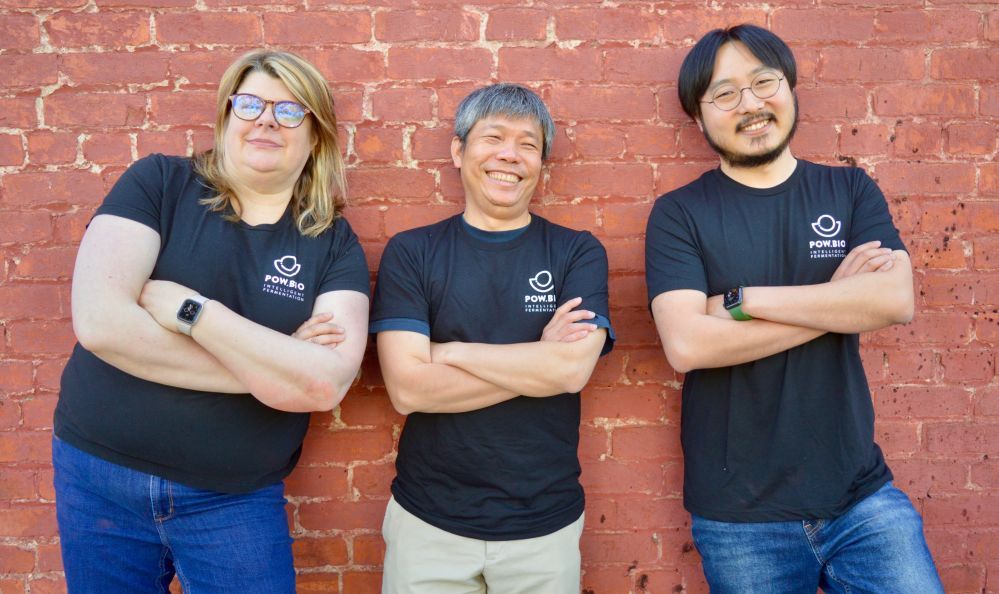Thanks to synthetic biology, engineered microbes can now make everything from carotenoids to human milk oligosaccharides. But the bioeconomy will only take off if the precision fermentation process can be made more efficient, says Berkeley-based startup Pow.bio.
In a traditional batch precision fermentation process, says cofounder and CTO Dr. Ouwei Wang, microbes proliferate until they reach critical mass in a fermentation tank and are then triggered to start producing a target molecule via a change in the media. The batch is then completed, the ingredient is extracted, the tank is cleaned, and the whole process starts all over again.
Pow.bio, founded by Dr. Wang and Shannon Hall in 2019, has found a way to maintain microbes in an ultra-productive state for weeks in a process it claims can cut capex costs and increase biomanufacturing capacity by orders of magnitude by combining continuous fermentation with advanced control methodology.
AgFunder News (AFN) caught up with Wang (OW) at the recent SynBioBeta conference to find out why this approach could make the economics of precision fermentation far more appealing.

AFN: What problem is Pow.bio solving?
OW: You can make pretty much anything using precision fermentation; the problem is how to make it price competitive. We typically see a 5- to 10-fold increase in productivity [when using a continuous versus a batch process] for the same ingredient.
By increasing productivity, you can also save on capex. As you’re running a fundamentally more efficient system, you can reduce the facility footprint; you can use fewer tanks and smaller tanks – therefore driving down the capex and opex, and ultimately the costs of goods. Smaller, less expensive manufacturing systems are easily distributed and co-located with feedstocks, enabling supply chains to be shorter. Then these smaller and affordable platforms can also unlock the business case for a wider variety of products.
We’re running continuous fermentation in our facility at the 30-liter scale and are now scaling up to 300-liters. We’ve worked with an independent consultant that does techno-economic modeling and we project eight times higher productivity at commercial scale using 50 cubic meter [50,000-liter] reactors for continuous vs a batch process for certain ingredients.
AFN: Why might a continuous process be favorable to a batch process?
OW: A batch process is slow and repetitive. Every time you set up, you need to sterilize everything, grow the cells, trigger them to produce the product, harvest it, and repeat this process over and over and over.
There’s a burst of productivity and then it drops to zero, a burst of productivity and then it’s back to zero, again and again. Whereas in the traditional chemical industry, you are continuously converting and catalyzing the feedstock into the value-added product, so that’s just a much more efficient process.
AFN: If a continuous fermentation process is more efficient, why isn’t everyone using it?
OW: In the continuous microbial fermentation space, there are two major limitations: contamination and strain mutation.
A batch system is a closed system, so as long as you don’t have a contaminant that gets into the bioreactor on the first day, it’s very unlikely it would overtake the bioreactor and cause the whole thing to crash.
This is different in a continuous reactor, where there is media coming in and product coming out 24/7, and more human intervention, so there’s a higher chance for contamination.
And then on the strain mutation side, if you’ve got a continuous process, over time, you can get mutations, whereas in a batch process, it’s a limited problem because we hit the reset button every few days. In a continuous process, you cannot reset because that defeats the whole purpose.
AFN: So how has Pow.bio overcome these challenges?
OW: We developed a dual-chamber system that separates the growth phase [where the microbes proliferate] from the production phase [where the microbes start producing the molecules of interest] in the bioreactor.
So in the growth reactor we ensure that there is no production of the product. In the production chamber, meanwhile, we shut off growth altogether by using nutrient limitation, so the cells lack essential building blocks to proliferate; they are in a zombified state, actively producing but not growing. And because of that, the contaminants can’t overtake the production phase. It’s not that we’re completely immune to contamination, but we are much more resilient; contaminants never cause our reactor to crash.
But we are not a hardware company; the innovations are in the process, not in the hardware.

AFN: How long can you keep running precision fermentation using your process?
OW: Technically, indefinitely, but we typically run this for three to four weeks for scheduling reasons. Around 21 days or 500 hours is fairly typical. And according to our techno economic analysis, we can vastly amplify productivity if we can hit that 500+ mark.
AFN: How unusual is what you’re doing?
OW: Other companies have done continuous fermentation for biomass where the end product is the bacteria or yeast cells themselves. Our solution is broadly applicable for precision fermentation, where the product is made by the bacteria or yeast. In the past, continuous precision fermentation was rarely successful due to contamination and strain mutation, with some exceptions such as Cargill’s ethanol production process and LanzaTech’s continuous gas fermentation process. In these cases, the product produced is toxic and thus naturally serves as a biocide that prevents contamination.
(Editor’s note: Read more about continuous fermentation at Australian startup Cauldron Foods.)
AFN: What is your business model?
OW: We are a ‘fermentation as a service’ company. We provide intelligent fermentation services to the biomanufacturing industry; we help other companies validate their strains, optimize their process and produce materials for regulatory and go to market testing, with the aim to manufacture for them with our continuous technology.
Down the road we are also looking at joint ventures with other companies to license our technology and to build a factory with them to produce their own products.
AFN: Does your process only work with certain microbes producing certain ingredients?
OW: We’ve worked with bacteria and yeast and we’ve produced high value organic acids such as mevalonolactone, food proteins and other ingredients.
Biomanufacturing is kind of bipolar. At one end you’ve got people focusing on the most expensive stuff like lactoferrin, because biology is expensive. At the other end you’ve got people using it for extremely cheap stuff like citric acid and ethanol, acetone and butanol.
But there’s a massive gap in the middle that is currently occupied by the petrochemical industry, traditional agriculture, and animal husbandry, and that’s where I see a huge opportunity for synthetic biology to take over and produce ingredients in a more sustainable manner.
AFN: Can you produce dairy proteins via continuous fermentation?
OW: Yes, we can produce dairy proteins such as whey, casein, and lactoferrin via continuous fermentation.
AFN: How have you funded the company and what progress have you made so far?
OW: We raised $1.5 million in a pre-seed round in 2019 and then a similar amount as a bridge round.
It’s a difficult time to raise money but I think investors are interested in us because we are working to address some of the biggest problems in precision fermentation.
We plan to expand our capabilities in 2023 as we’re working with 30 different clients, and right now we don’t have the capacity to serve all the incoming demand. We are also moving to a new facility where we can support much larger fermentation volumes and greater capacity.
AFN: When will you start generating revenue?
OW: We are already generating revenue. People come to us for different reasons. Sometimes they want to know which strain is the best for their ingredient. Sometimes they say, ‘In our current process we make this ingredient with a productivity of X, a titer of Y and a yield of Z. Can you make it better?’
Other people just come to us and say, ‘I need a kilo of product X, can you make it for us?’
We use our unique technical capabilities to accelerate product development by months or even years and provide a technical path that achieves target unit costs. We can handle everything from optimization to production. For example, we have an optimizer that can read the current state of the reactor [during the continuous fermentation process] and from there, we can adjust fermentation conditions to achieve a better productive state.
You adjust, re-calibrate, and self-correct to stay at high productivity over a long period of time. And you can’t do this with a batch process.
AFN: What IP do you have?
OW: We have IP on contamination controls produced during my PhD at UC Berkeley, which they have licensed to us, and we also have a growing patent family addressing our process innovation and optimization technologies.
Further reading:
🎥 Precision fermentation: When does it make commercial sense?



